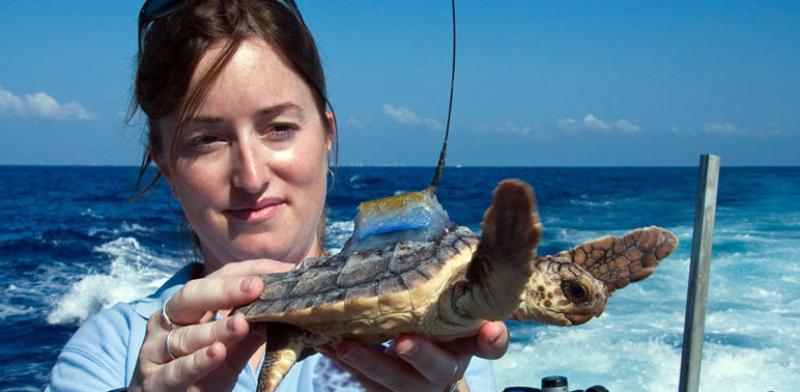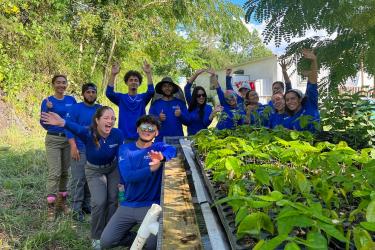Loggerhead sea turtles begin their adventure at a very early age. After hatching, they waddle off the beach into the surf and begin a journey that takes them clear across the ocean. Many loggerheads from the U.S. Atlantic coast turn up a few years later in the Canary Islands off West Africa. But how they get there, and what they encounter along the way, has long been a mystery.
Biologists had referred to this period of time as the sea turtles’ “lost years.” But those years are no longer lost to science. Kate Mansfield, who was doing her postdoctoral research at NOAA’s Southeast Fisheries Science Center at the time, led the team of university scientists that tracked the turtles’ migrations.
“What is exciting is that we provide the first look at the early behavior and movements of young sea turtles in the wild,” said Mansfield, who is now a biologist at the University of Central Florida.
They did that by attaching satellite tags to 17 young loggerhead sea turtles. The small, solar-powered tags allowed scientists to map the animals’ migrations. The tags also beamed back data on the environmental conditions the turtles encountered along the way.
The Keratin Connection
Scientists have been using satellite transmitters to track the migrations of marine animals for years. To track adult sea turtles, scientists glue the transmitter to the animal’s shell. But baby sea turtles start so small and grow so quickly that their fast-expanding shells quickly shed whatever scientists attach to them.
The solution to that problem came from an unlikely source. Marisol Marrero is a nail salon technician at Not Just Nails in Boynton Beach, Florida. One of the authors of the study, Jeanette Wyneken of Florida Atlantic University, is an occasional customer.
During one of her visits to the nail salon, Wyneken explained the difficulty in attaching satellite tags to the baby sea turtles. Sea turtle shells are made out of a protein called keratin, the same stuff that fingernails are made of, so Wyneken asked Marrero for advice.
“Have you considered using an acrylic base coat?” asked Marrero, referring to her technique for attaching artificial nails at the salon. The rest is history.
A Few Surprises
Scientists had long assumed that Atlantic loggerheads hitch a ride on the North Atlantic Gyre, a circular system of currents that flows clockwise from North America to Europe and Africa, then flows back near the equator. That would explain how the young turtles made their way to the Canary Islands. But the satellite tags revealed that many turtles hop off the gyre to swim in the Sargasso Sea, which occupies a calm area inside the gyre. The sea is named for sargassum, a seaweed that collects there and, like a forest in the middle of the ocean, offers shelter and habitat to a diversity of marine creatures.
Temperature sensors on the satellite tags indicated that when in the Sargasso Sea, the turtles experienced warmer water temperatures than would be expected based on data from remote sensing satellites and data buoys. This may be due to the brown sargassum absorbing more of the sun’s energy than the open water around it. The scientists speculate that young sea turtles might detour into the sargassum habitat to warm up. Since the animals are cold-blooded, warmer water would accelerate their growth and help them to outgrow predators more quickly.
“Understanding what these animals are doing during their early life history is critical to better managing the species,” said Mansfield. This is particularly important for Atlantic loggerhead sea turtles in U.S. waters, which are listed as threatened under the Endangered Species Act.


